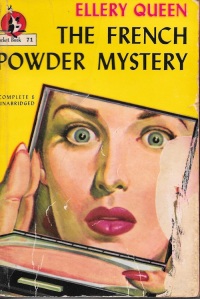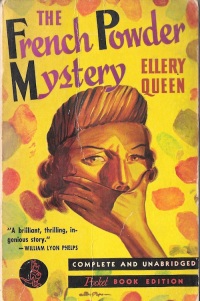 My initial experience reading Ellery Queen with The Roman Hat Mystery was a mixed bag, slanting heavily towards disappointment. I had an exciting start, gobbling up the maps, false forwards, and dramatis personæ preceding the start of the actual story. The investigation started out fairly interesting, but as the book wore on, I came to the slow uncomfortable realization that investigation was all I was going to get. The sleuthing and police work was enjoyable enough, but one dimensional. It was only really at the end when the wheels came off. The stark reality that 300 pages of interviews, interrogations, and painstaking searches was all for nothing. There was no twist to satiate my curiosity, no clever misdirection to be unveiled.
My initial experience reading Ellery Queen with The Roman Hat Mystery was a mixed bag, slanting heavily towards disappointment. I had an exciting start, gobbling up the maps, false forwards, and dramatis personæ preceding the start of the actual story. The investigation started out fairly interesting, but as the book wore on, I came to the slow uncomfortable realization that investigation was all I was going to get. The sleuthing and police work was enjoyable enough, but one dimensional. It was only really at the end when the wheels came off. The stark reality that 300 pages of interviews, interrogations, and painstaking searches was all for nothing. There was no twist to satiate my curiosity, no clever misdirection to be unveiled.
Yet, I’m not going to dock an author for a first book, especially one as well respected as the Queens. The next in line was The French Powder Mystery, and reputation was that it featured a rather notable ending. Well, actually, I came in knowing exactly what makes the ending notable because I did a bit more blog reading than I should have (a bad habit that I’m trying to ween myself from). Fortunately, I didn’t learn anything that ultimately detracted from my experience.
I don’t hold my preliminary research into Queen to be airtight in any sense – in fact I’m sure there’s much I’ll laugh at in hindsight. What I have noticed though is that when bloggers mention key moments that stand out in Queen’s catalog, The French Powder Mystery typically makes the grade. Well, there are contrary opinions to that… JJ at the Invisible Event recently gave the book the most enjoyably grating review that I can recall. I walked into this one cautious due to my experience with The Roman Hat Mystery, yet thinking that maybe JJ was having a bad week.
The basic premise of The French Powder Mystery revolves around a murder at a multi-story department store. A showroom facing the street features a daily exhibit of the most modern amenities, such as a concealed wall bed. Onlookers gather to gawk at the latest in European furnishings, only to recoil in horror as a the body of a dead woman tumbles from the fold down bed. The victim is the wife of the department store owner, and she’s been shot twice at close range.
The Queens arrive to investigate, although this time the story focuses almost exclusively on Ellery. Interviews with the store workers, security, and management reveal some curious findings. The victim had entered the department store late at night after all the workers had gone home. She signed in with security and then took an elevator to the top floor, where the owners kept a private apartment. She wasn’t seen again until the next day, when her body was discovered in the display.
The department store was locked up, closely guarded, and patrolled by a security team. It seems inconceivable that a gunshot wouldn’t be heard, or that a killer could slip in and out of the display where the body was found without being seen. We even have a map of the building to study so we can contemplate how such a difficult crime could have been committed.
 An investigation of the the top floor apartment (augmented with second map) reveals that the victim had been there, and wasn’t alone. Ellery stumbles upon a number of small clues – a missing razor blade, misplaced clothes, a bookend with specks of a strange powder – to name a few. We also learn that the daughter of the victim is missing, and as the story progresses, all of the evidence slowly starts to point towards her.
An investigation of the the top floor apartment (augmented with second map) reveals that the victim had been there, and wasn’t alone. Ellery stumbles upon a number of small clues – a missing razor blade, misplaced clothes, a bookend with specks of a strange powder – to name a few. We also learn that the daughter of the victim is missing, and as the story progresses, all of the evidence slowly starts to point towards her.
Like the book before it, The French Powder Mystery is fairly one dimensional, focusing purely on Ellery’s investigation of the crime. There is no added fluff of comedy, romance, atmosphere, or adventure. Ok, I can kind of live with that – I don’t read these books for those elements, I read them for the puzzle. I can put up with a respectably written investigation if the story pays out in the end. In a sense, this one does.
For one, the authors provide a more steady pace of interesting revelations as the story progresses. Nothing profound or cliff hanging in nature, but enough to continually draw your interest. As an example, Ellery raises the question of why the killer took such pains to hide the body in the fold down bed, knowing that it is opened as part of a daily exhibit at a predicable time. What did that effort and risk buy the villain?
The conclusion is a bit of a mixed bag, but I think that I’ll remember it for the positive aspects. The downside is the answer to the question of “how?” – how was a woman shot twice without being heard by guards? How was the killer able to slip in and out of the display without being seen, given the placement of the security desk and the constant patrols? The answer to that veers closely into The Roman Hat Mystery territory – if you think you’re going to get some clever solution, be prepared to walk away unsatisfied.
The solutions to both The Roman Hat Mystery and The French Powder Mystery are just so simple from a “how” point of view. Typically when I use the term ‘simple’ to refer to the solution of an impossible crime, it is the highest compliment that can be paid. The White Priory Murders – beautifully simple. It Walks By Night – face slappingly simple. These two Queen books do not fall into that category at all. This is more of a “oh, I guess the authors didn’t really think the ‘how’ was that important” simple.
Conventionally, that leaves us with the prospect of a strong “who?” and “why?” to deliver a memorable ending. I wouldn’t quite say those are strong suites either, although the “why?” does have some grace to it. Where The French Powder Mystery really excels is how the ending unfolds. It’s no masterpiece, but it is downright thrilling.
Start of a section that doesn’t contain spoilers, but does discuss the format of the unveiling
Ellery assembles a massive cast – basically every character in the book – for a speech during which he’ll expose the murderer. Similar to The Roman Hat Mystery, there has been no clever misdirection in the book. All of the clues have been out in the open and rehashed many times. You just have to step back and stitch them together correctly to understand what really happened. Ellery does this, applying each clue as a filter, checking off swaths of the potential suspects. As each clue is revealed, the circle grows tighter and the tension is palpable. The suspects dwindle until only a few remain. As the final piece of evidence is laid out, all heads turn to face…
End of discussion of the unfolding of the ending
It really is a thing of beauty. I’m sure that there are better denouncements, but I have to think really hard about whether I’ve read one. My heart still beats a little faster as I play it back in my mind. Sure, I’ve read better endings to mysteries – 80% of John Dickson Carr books probably qualify. The French Powder Mystery separates itself from the pack in terms of the actual process that the detective uses to build tension and reveal the killer.
 So how do I grade this? Mmm, tough question. This is still an improved effort over the first Queen novel, that is for sure. It’s fairly long, and I only mention that because it is so heavy on investigation. Not too much of the story stands out to me except the beginning and the ending. But the ending is good, and I suppose that is what matters to me the most.
So how do I grade this? Mmm, tough question. This is still an improved effort over the first Queen novel, that is for sure. It’s fairly long, and I only mention that because it is so heavy on investigation. Not too much of the story stands out to me except the beginning and the ending. But the ending is good, and I suppose that is what matters to me the most.
What do I make of Queen so far? Well, the mysteries aren’t what I was expecting. These are more along the lines of a police drama, with all focus really just on the investigation. There are puzzles, but they aren’t what I’m used to. No impossible crime, no subtle misdirection, no hidden dimension to the story. Instead, the clues are all out there on the table and discussed extensively. The puzzle is to match wits with the detectives (and authors) and assemble them into a clear arrow pointing at the culprit. Even there, I think most readers will say that there are some logical leaps that get taken. The key clue that points to the killer in The French Powder Mystery could be discarded with as simple a phrase as “maybe they just hadn’t noticed.”

You definitely like this more than I did, but that doesn’t really say much. I cmpletely agree with you summation of the Queen mystery style based just on these first two books — yes, yes, I’m sure it changes and we get something more akin to the mysteries they’re celebrated for, but it’s interesting just how different these have been compared to what I was expecting.
LikeLike
You seem to have had a slightly better time with this book. Good. Stick with them, the stories, or the stye of telling them, do evolve and you will encounter those that fit more closely with what you particularly like.
LikeLike
Sorry that you didn’t like it as much… If I recall correctly, I quite liked ‘Roman Hat’, and I liked ‘French Powder’ even more – but as puzzles rather than novels. I think of all the Queen novels I’ve read, the only one that I thought presented itself as a great story and narrative was ‘Face to Face’.
LikeLike